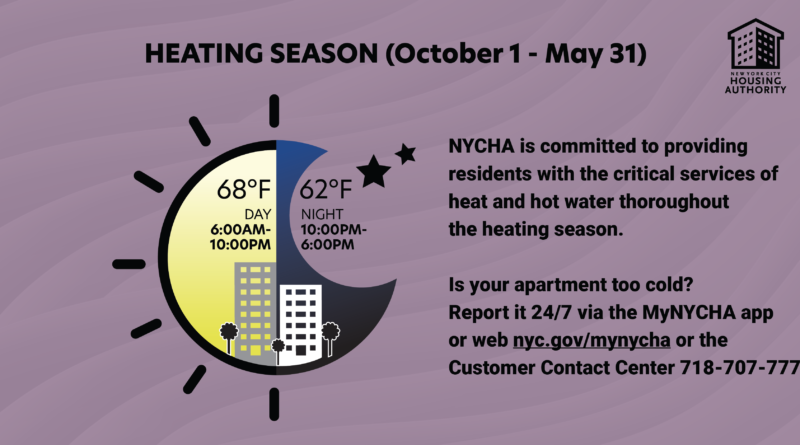Heating Season Has Begun
The winter heating season runs from October 1 through May 31 in New York City. In preparation for the upcoming cold weather, NYCHA’s Heating Management, Operations, Emergency Management, and Capital Projects departments have been working collaboratively throughout the year to repair and maintain the Authority’s extensive network of boilers, distribution equipment, and hot water systems that deliver heat and hot water service to public housing residents across New York City.
“NYCHA fully understands the impact that heating outages have on residents, which is why we work throughout the year to prepare for the cold weather,” said NYCHA’s Chief Operating Officer Vito Mustaciuolo. “The Authority continues to improve the quality of our heating equipment and increase the capacity of our staff and vendors to promptly address our residents’ needs.”
Each year, beginning October 1, all New York City building owners must maintain an indoor temperature of at least 68 degrees between 6 a.m. and 10 p.m. when it’s below 55 degrees outside. From 10 p.m. to 6 a.m., indoor temperature must be at least 62 degrees, regardless of the temperature outside. Hot water must be kept at a minimum temperature of 120 degrees at the source year-round.
Over the past three years, NYCHA has significantly reduced heat outages from 1,127 outages in the 2018-2019 heating season to 582 in the most recent 2020-2021 season. The average restoration time also dropped from 8.8 hours to 7.3 during the same period.
NYCHA has approximately 600 Heating Management Services Department staff members who are dedicated to extending the life of the Authority’s boilers and related heat distribution equipment year-round. As part of these efforts, they conduct preventative maintenance on heating infrastructure during the summer months and established a 24/7 Heat Desk that provides remote monitoring of heating plants. The Authority also implemented a new staffing model that deploys heating plant technicians and plumbing teams to promptly respond to outages during evening and overnight hours. To prepare for this year’s heating season, the Authority continues to increase its stock of mobile boilers and is in the process of investing $28 million in operating funds to replace more than 500 heating infrastructure components, including hot water boilers and systems, heat control panels, vacuum tanks, oil transfer pumps, and other critical equipment.
NYCHA works with partner City agencies such as the Department for the Aging (DFTA) and the Department of Youth & Community Development (DYCD) to open warming centers for its residents when necessary. As part of NYCHA’s Transformation Plan, there is increased emphasis on communications related to these efforts — ensuring residents are proactively notified about planned outages through flyers and robocalls, providing regular updates on service restoration, and improving the technology for residents to inform NYCHA staff if they are experiencing lingering issues related to the restoration of service.
Residents experiencing issues with heat or hot water should call the Customer Contact Center at 718-707-7771 or report the issue via the MyNYCHA mobile app or web version. They should also contact NYCHA when:
- The temperature is out of range: The temperature in their apartment should never fall below 68 degrees during the day or 62 degrees at night.
- They have hot pipes and cold radiators: If the riser pipes are hot and the radiator is cold, residents should first make sure the hand valve is open (to the left). If the valve is open and the radiator is still cold, residents should tell NYCHA staff and ask them to change the radiator trap.
- The window is not closing properly: Residents should request window repair if the window is not closing all the way or if air is coming in above, below, or between the sashes.
- Steam is leaking into the apartment: Residents should ask NYCHA staff to fix all steam leaks immediately.
- The building’s front entrance door does not fully close.
Some best practices for helping to keep apartments warm during the winter months include:
- Keeping windows fully closed, top to bottom, because open or leaky windows can make you feel cold even if the heating system is working as it should. If they feel air, residents should contact NYCHA.
- Consider removing the window air conditioner, or covering it, for the winter. Leaving an air conditioner installed in the window is the same as having a six-inch hole in your wall. If residents cannot remove and store their air conditioner for the winter, they should consider insulating it with a cover and weather-stripping around the sides to reduce cold air coming in.
- Moving furniture away from radiators or baseboards to keep the air moving freely. If radiators/baseboards are blocked by furniture, they will only heat what is in front of them and not the rest of the room.
- Opening the hand valve on the radiator. Turn the knob to the left to open it (more heat) and the right to close it (less heat).
- Lowering blinds or draw curtains at night. Warm air hitting a cold window will cause a draft, even if there’s no cold air coming in from the outside. The curtains or blinds prevent drafts.
- Keeping hallway and stairwell windows closed. Many are left open year-round, letting in cold air all winter.
For more information and resources, visit the nyc.gov/extreme-cold-weather page.

